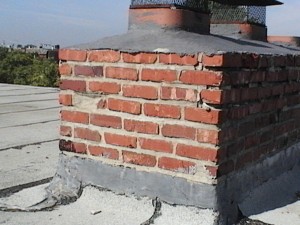Water may seem harmless enough, but it can cause serious damage to your chimney. Don’t believe me? Have you ever been to the Grand Canyon? Well, how do you think it was formed? Water can have devastating effects on masonry work if allowed to go untreated. In fact, over $1,000,000,000 of damage to masonry chimneys occurs every year from water. And just in case you missed it, that was billion, with a B!

Water causes the brick spalling you see here.
Because chimneys are 100 percent susceptible to the elements, it is vital that they are treated for waterproofing as well as inspected on an annual basis. If damage is caught early, the repairs may not be so costly. If undetected, the homeowner may end up with both outside masonry repairs as well as liner repairs.
There are multiple entry points on a chimney that can create water damage over time. If the chimney cap is missing or damaged, water will have direct access to enter the chimney during storms. Structural damage may also occur if the flashing is damaged or missing. Another source of water damage can be your rain gutters. If the chimney extends below ground level and the runoff spout is located in the same area, it can eventually cause structural damage.
To see if your chimney has been damaged by water, look for these signs:
- Is your damper showing signs of rust?
- Is there water running out of the base of the chimney?
- Are there soot stains or white powder stains on the outside of the chimney?
- Do you see damp water spots around or inside the chimney?
If any of these signs are present, it is time to schedule a chimney inspection. A professional inspector will be able to locate the exact source of the damage and recommend repairs. If you have not had a chimney inspection in the last year, you should still schedule a professional chimney inspection and cleaning, even if you do not see any of these signs of water damage.
